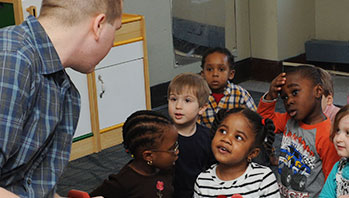- audio player
- chart paper
- different music clips (jazz, blues, classical, salsa)
- marker
- music
MA Standards:
Speaking and Listening: SL.PK.MA.1 Participate in collaborative conversations with diverse partners during daily routines and play.
Language: L.PK.MA.1 Demonstrate use of oral language in informal everyday activities.
Language: L.PK.MA.6 Use words and phrases acquired through conversations, listening to books read aloud, activities, and play.
MA Draft STE Standards:
Physical Sciences/Matter and Its Interactions/PS4.B Apply their understanding in their play of how to change volume and pitch of some sounds.
Head Start Outcomes:
Language Development/Receptive Language Attends to language during conversations, songs, stories, or other learning experiences.
Language Development/Expressive Language Uses language to express ideas and needs.
Social Emotional Development/Self-Concept and Self-Efficacy Identifies personal characteristics, preferences, thoughts, and feelings.
PreK Learning Guidelines:
English Language Arts/Language 2 Participate actively in discussions, listen to the ideas of others, and ask and answer relevant questions.
Health Education 16 Recognize and describe or represent emotions such as happiness, surprise, anger, fear, sadness.
Talk Together: Feeling the Music

© Commonwealth of Massachusetts, Department of Early Education and Care (Jennifer Waddell photographer). All rights reserved.
STEM Key Concepts: Sounds vary in three ways: volume (loud or soft); pitch (high or low), and timbre (quality)
ELA Focus Skills: Listening and Speaking, Vocabulary
Ask children to recall the music and singing from Between the Lions “Ruby Sings the Blues.” Tell children you are going to have them listen to different types of music. Say, There are many different styles of music, such as jazz and the blues. Different styles of music can make us feel different ways. Talk about how different music can make you feel happy, sad, or even silly. Ask children, Do you have any favorite songs? Why are they your favorite? Do they make you feel sad, happy, or silly?
Play a piece of music; then ask, How did that make you feel? Encourage children to use vocabulary words like happy, sad, or silly to describe the way they feel.
Repeat with one or two more pieces of music from a different genre. Record responses on a “Music Makes Me Feel . . .” chart.
